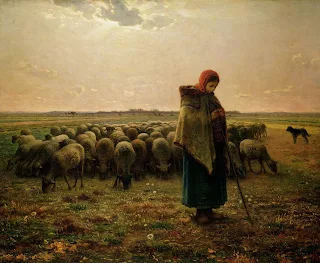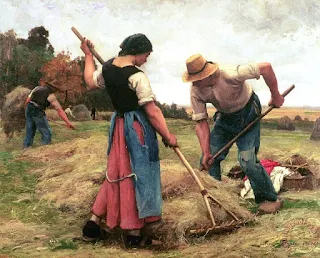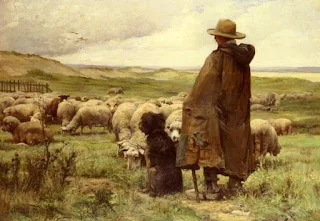The Barbizan artists were most active from approximately 1830 until 1870. They headquartered in Barbizan, France approximately 35 miles south-southeast of Paris on the edge of the Fontainebleau Forest.
The life they documented was a mix of intensive crop and extensive pastoral agriculture. I find it aesthetically pleasing. One can make a case that traditional, European small-holdings combined both types of agriculture in an ecologically stable way. These are still considered state-of-the-art principles and are taught in permaculture classes.
Most of these images are from one artist, Jules Dupré. I chose him in particular because he provides good images of the tools of the common worker in the field.
 |
| Yokes for carrying. I am hand carrying water to the cattle right now, so I can appreciate the advantage of a yoke. Front and rear views provided. |
 |
| A detail of the fork that is shown in many of Dupré paintings. This shows the same split/wedge/lashing construction and steam-bent claws. |
 |
| A wheelbarrow, windmill and woman with patched, work-dress |
 |
| Dupré painted many versions of this image. It must have been a big seller. I selected this version because it shows the mallet, peg and chain in detail. |
 |
| A group of other women are in the background. It is not clear if they are watching their own sheep or not. |






Very nice art. I've never seen Jules Dupre's work before. Thanks for sharing it. From the looks of those girl's forearms they could win lots of beer arm wrestling college boys. ---ken
ReplyDeleteAlmost every time you do your fine art tues. you end up pointing out small details that I end up having to save, then open in a photo prgm so I can enlarge them only to say "well, looky there. With that in mind, I'm not entirely convinced that the woman is wearing a patched work dress. More than half the women are obviously wearing aprons of one sort or another. And why not? In that era(the mid 1800's) the powered loom was just about to become the norm. Most cloth was produced by hand. While it's true the powered loom was invented around 1780 it didn't become common for several decades. People had to take care of their clothes and did. Cowboys wore chaps to protect their pants from getting snagged and ruined by brambles and the like. Smiths wore leather, cooks aprons to protect from stains an such. I'm not sure when farmers started wearing bib overalls but the same principles apply. So, what do you think "prof" did I pass your test?
ReplyDeleteGreat catch. You are absolutely right.
DeleteThree gold stars for thee.